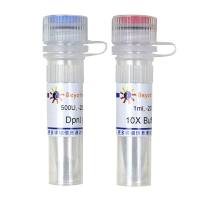Site-Directed Mutagenesis Facilitated by DpnI Selection on Hemimethylated DNA
互联网
502
Oligonucleotide-based, site-directed mutagenesis (SDM) of cloned DNA has become a fundamental tool of modern molecular biology,
used to introduce insertions, deletions, and substitutions into DNA. Current techniques available for performing in vitro
mutagenesis fall into three categories:
| 1. |
Those employing single-stranded DNA (ssDNA) as template (1
,2
), originally using phage M13 vector to produce the ssDNA. Several methods were developed to reduce the background of nonmutated
parental DNA, including in vivo incorporation of uracil in the parental strand (3
,4
), and in vitro incorporation of 5-methyl cytidine or thiophosphates in the synthesized strand (5
,6
). Selection against the parental strand was accomplished during intracellular DNA repair, or by differential restriction
endonuclease sensitivity in vitro, respectively.
|
| 2. |
Use of double-stranded DNA (dsDNA) as template. A widely used method called unique site elimination (USE) (7
) allows introduction of specific mutations into a target gene or region cloned into a ds plasmid with a unique restriction
site.
|
| 3. |
Polymerase chain reaction (PCR)-based methods, in which site-specific mutants are created by introducing mismatches into oligonucleotides
used to prime in vitro amplification (8
–11
). Such methods often include splicing by overlap extension, which involves a two-step PCR procedure, and subsequent cloning.
|









